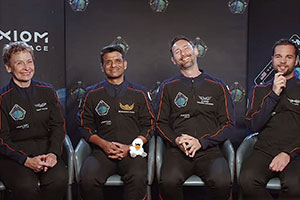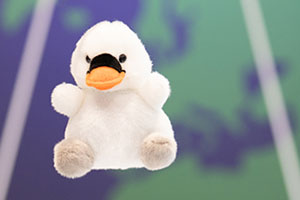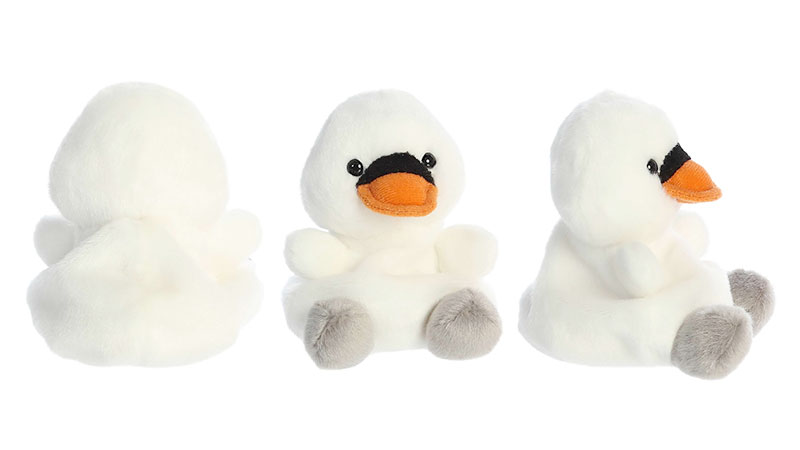 advertisements advertisements
|

|
'Joy,' a plush baby swan, to launch with Ax-4 crew as zero-g indicator
June 3, 2025 — When an international astronaut crew lifts off on a commercial space mission this month, they will be joined by a स्वैन, a łabędź or a hattyú.
Or, in English, a swan.
The Axiom Mission 4 (Ax-4) astronauts, including American commander Peggy Whitson, Indian pilot Shubhanshu Shukla and mission specialists Sławosz Uznański-Wiśniewski of Poland and Tibor Kapu of Hungary, chose a small plush swan named "Joy" as their zero-gravity indicator. The doll, attached to a tether, will be released to float aboard the SpaceX Dragon capsule, signaling that the Ax-4 crew safely made it into low Earth orbit.
"Joy, the baby swan, embodies the shared pursuit of the Indian Space Research Organisation (ISRO), the European Space Agency (ESA) and the Hungarian to Orbit program (HUNOR) to soar high above our home planet," read Axiom Space's description of the zero-g indicator. "In this way, Joy represents cultural unity as three nations realize the return to human spaceflight, together as one crew."
The Ax-4 crew chose a swan because it symbolizes similar characteristics across their different countries.
"'Joy' represents the shared aspirations of three nations united in their return to human spaceflight," said Whitson as she revealed the zero-g indicator during the crew's pre-launch press briefing on Tuesday (June 3). "This one is rich in cultural symbolism. It stands for wisdom in India, resilience in Poland and grace in Hungary. Through 'Joy,' we'll celebrate our diversity and our unity in the shared journey of space exploration."
"In Indian culture, the swan is the vehicle of Goddess Saraswati, symbolizing wisdom, learning and purity," said Shukla. "It is said to have the rare ability to separate milk from water, a symbolism that is a powerful reminder of discernment in an age of distraction. To carry the symbol is to carry the essence of our mission: pursuit of knowledge, clarity of purpose and grace under pressure."
"The biggest journey is about to start in just couple of days. I still do not realize how big this moment will be," said Uznański-Wiśniewski. "This will be such a joy, just as the name of our extra passenger in our Dragon and on the ISS."
The Ax-4 crew arrived at a baby swan after deciding they wanted it to be animal, as inspired by the interests of one of their children.
"We wanted to go with with a dinosaur or a lion, but we just couldn't find the right one," said Kapu. "We were extremely happy when we found 'Joy.'"
"Joy," as named by Kapu, is otherwise known as "Alina Swan," a part of Aurora's "Adorable Palm Pals" line of pocket-size play dolls. Measuring all of 5 inches tall (12.7 meters), Joy/Alina is fluffy to the touch and is filled with bean pellets, such that (in a gravity environment) it sits in your hand or wherever you chose.
Flying zero-g indicators is a tradition that can be traced back to the first human spaceflight in 1961. Soviet-era cosmonaut Yuri Gagarin brought a small doll with him on his Vostok mission to see it float. Since then, the Russian crews that followed Gagarin into Earth orbit, flew small dolls, often chosen by their children.
The custom reached the United States with the introduction of crewed capsules after the end of the space shuttle program. Now commercial spaceflights operated by SpaceX and Boeing, as well as NASA Artemis flights include zero-g indicators.
Once at the International Space Station, Joy will join the Expedition 53 dolls, including "Droog," a crocheted origami crane, flown by SpaceX's Crew-10 and an angel blowing a horn selected by Russia's Soyuz MS-27 crew.
"A team that has joy is a team that is healthy," said Kapu. "That has become my personal motto because it captures the essence of this crew. We are focused, we are committed, but above all, we are joyful, and the joy is a sign of trust, resilience, and in my mind, friendship. So in the spirit of sharing that joy, we wanted to bring one more crew member with us, a symbol of what holds us together."
It is believed that "Joy" is the first swan to be used as a zero-g indicator. Northrop Grumman, an aerospace company that resupplies the space station for NASA, had swan dolls made in reference to its Cygnus-series of cargo vehicles, but they were not used for the same purpose. |
|

The Axiom Mission 4 (Ax-4) crew's zero-gravity indicator, "Joy," the baby swan, was chosen for what it represents in India, Poland and Hungary, the astronauts' home countries. (Axiom Space)

The Ax-4 crew with their zero-g indicator, "Joy." Left to right: Peggy Whitson, Shubhanshu Shukla, Sławosz Uznański-Wiśniewski and Tibor Kapu at a pre-launch briefing on June 3, 2025. (Axiom Space)

"Joy" is also known as "Alina," Aurora's "Adorable Palm Pal" that (in gravity) is designed to sit in your hand. (Axiom Space) |

Aurora's "Alina Swan" is now "Joy," the Axiom Mission-4 (Ax-4) crew's zero-gravity indicator for their launch to the International Space Station. (Aurora) |
|
When you purchase through links on our site, we may earn an affiliate commission. Here's how it works.

© 1999-2025 collectSPACE. All rights reserved.
|
|

|

|
